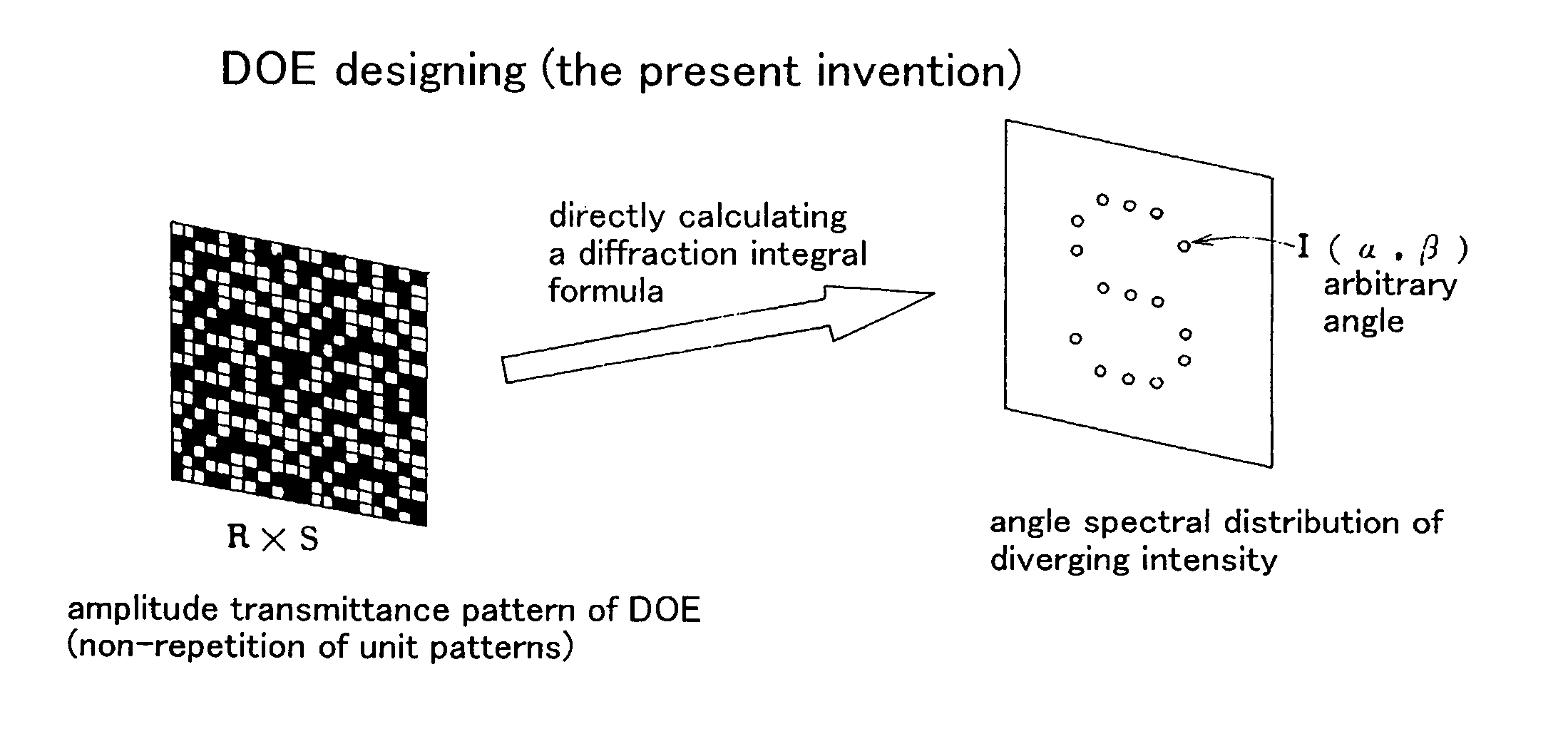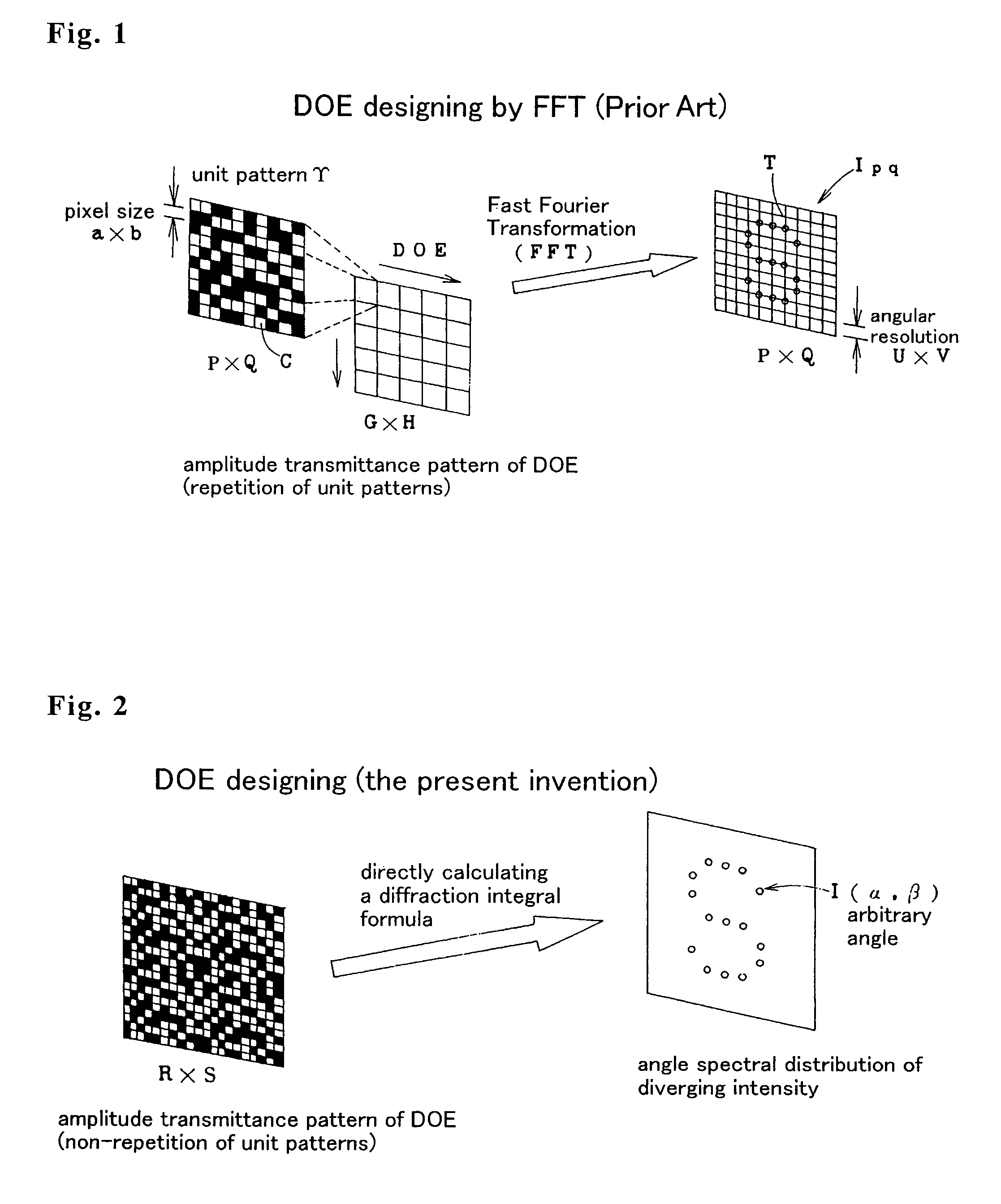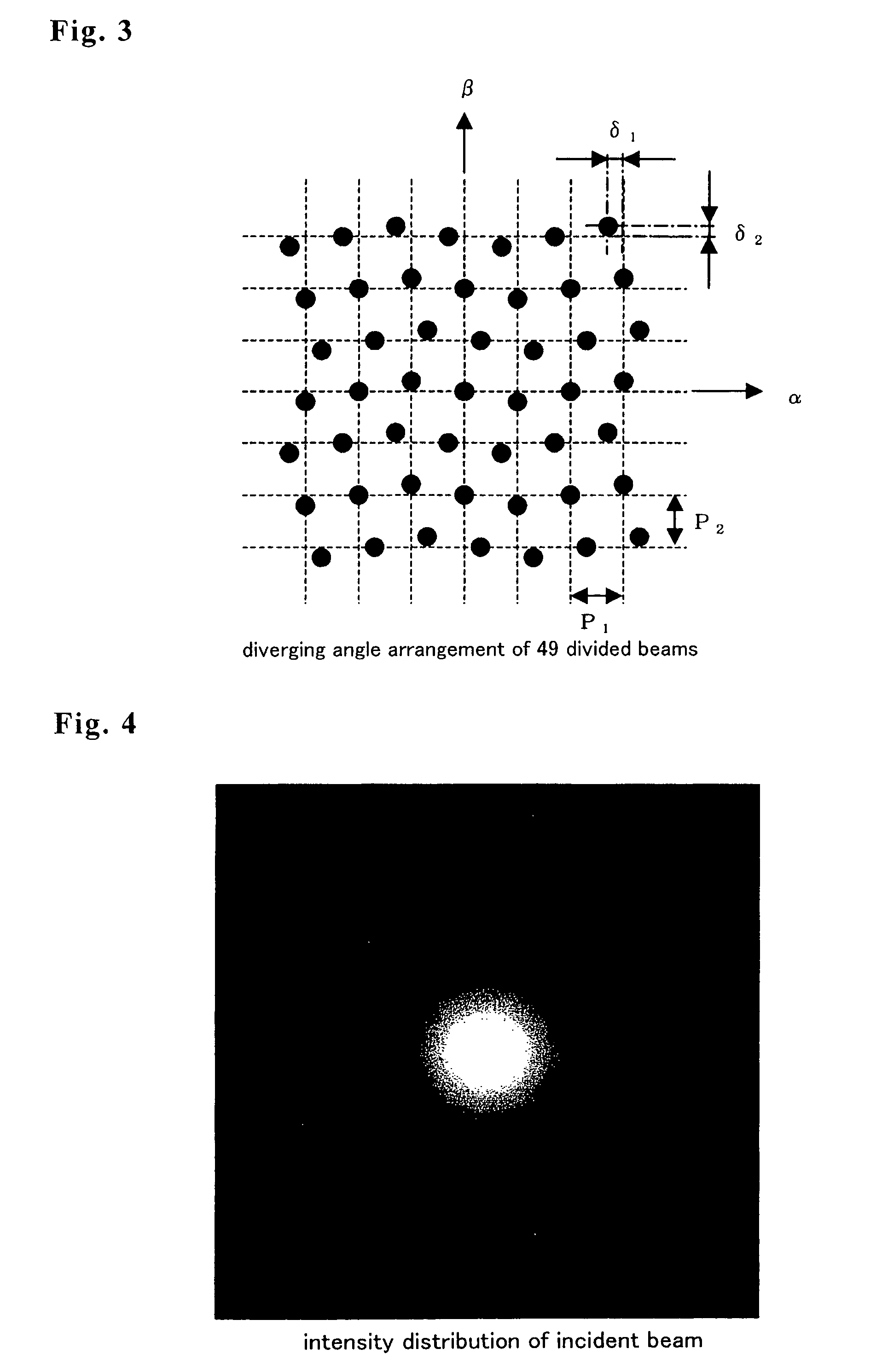Diffractive optical element
a technology of optical elements and optical elements, applied in the field of diffractive optical elements, can solve the problems of not many kinds of high-power lasers, and the reduction of the pitch of boring holes requires enlargement of unit patterns, so as to accelerate and reduce the cost of laser processing, the effect of free, precise laser simultaneous multi-point processing
- Summary
- Abstract
- Description
- Claims
- Application Information
AI Technical Summary
Benefits of technology
Problems solved by technology
Method used
Image
Examples
embodiment 1
DOE of Embodiment 1
[0135]Diffraction rate: 82.2%[0136]Intensity fluctuation: 1.6%[0137]Largest noise intensity: 3.6%
[0138]FIG. 4 is an incident beam intensity pattern. FIG. 5 is a DOE step distribution pattern. FIG. 6 is an image spot distribution pattern.
[C. Laser Processing Apparatus]
[0139]A laser processing apparatus is manufactured by combining a CO2 laser, the above-mentioned Fourier type DOE and a flat / convex lens (f=127 mm, 50.8 mm diameter, ZnSe). The spot diameter on an image plane is 171 μmφ.
[0140]An object arrangement of spots in angular space of Embodiment 1 is shown in FIG. 3. The abscissa is a horizontal angle α. The ordinate is a vertical angle β. It should be noted that this pattern is not an image pattern projected onto the image plane. 7×7 spots align in α- and β-directions. The beam spots are not all upon lattice points but slightly deviate from the lattice points.
[0141]Four (±2, ±2) points, four (0, ±2), (±2, 0) points and one (0, 0) point are on the lattice poin...
embodiment 2
DOE of Embodiment 2
[0161]Diffraction rate: 71.6%[0162]Intensity fluctuation: 1.7%[0163]Largest noise intensity: 3.5%
[0164]The pattern of the DOE is depicted by FIG. 7. Thickness (height) distribution (16 steps) of the DOE is represented by a black-white monochromatic tone. FIG. 7 shows a lattice-like pattern with narrow lattice constants. A fine structure of tones within lattices are obscure. The DOE (FIG. 7) of Embodiment 2 is entirely different from the former DOE (FIG. 5) of Embodiment 1. Since the branching beam angles are large, repetition of the DOE pattern is fine in Embodiment 2.
[0165]No unit pattern should exist in the DOE in FIG. 7. There should be no repetition of unit patterns having the same shape and the same size. But, the DOE seems to have quasi-regular repetition of spots in two dimensions like cloth. It may be marvelous. But, the deviations δ1 and δ2 are quite small in comparison to the pitches P1 and P2 in Embodiment 1. Then, the DOE becomes similar to the convent...
embodiment 3
[Embodiment 3 (Fresnel Type DOE, Small Diverging Angles)]
[A. Properties of the Fresnel DOE]
[0168]Wavelength: 10.6 μm[0169]Mode: TEMoo [0170]Beam diameter (1 / e2): 10 mm[0171]Step number of heights: 16[0172]Pixel size: a=20 μm, b=20 μm[0173]Pixel number: R=1000 pixels, S=1000 pixels[0174]DOE size: aR=20 mm, bS=20 mm[0175]Number of divided beams: 49 (=7×7)[0176]Diffracted beam pattern: FIG. 3, P1=3.93701 mrad, P2=3.93701 mrad,
δ1=0.15748 mrad, δ2=0.07874 mrad[0177]Fresnel type lens: focal length f=−500 mm
[0178]What is different from Embodiment 1 (Fraunhofer type) is that the DOE has a function as a lens. Since the DOE has the lens function, the DOE is called as Fresnel type. Embodiment 3 adds an f=−500 mm concave lens to the DOE. Of course, a convex lens can be added to the DOE instead of the concave lens.
[0179]Necessary resolutions U and V in x- and y-directions are
U=δ1=0.15748 mrad,
V=δ2=0.07874 mrad.
[0180]In Embodiment 3, λ / aR=λ / bS=0.53 mrad like Embodiment 1. These values of paramete...
PUM
| Property | Measurement | Unit |
|---|---|---|
| diameter | aaaaa | aaaaa |
| diameter | aaaaa | aaaaa |
| size | aaaaa | aaaaa |
Abstract
Description
Claims
Application Information
 Login to View More
Login to View More - R&D
- Intellectual Property
- Life Sciences
- Materials
- Tech Scout
- Unparalleled Data Quality
- Higher Quality Content
- 60% Fewer Hallucinations
Browse by: Latest US Patents, China's latest patents, Technical Efficacy Thesaurus, Application Domain, Technology Topic, Popular Technical Reports.
© 2025 PatSnap. All rights reserved.Legal|Privacy policy|Modern Slavery Act Transparency Statement|Sitemap|About US| Contact US: help@patsnap.com



